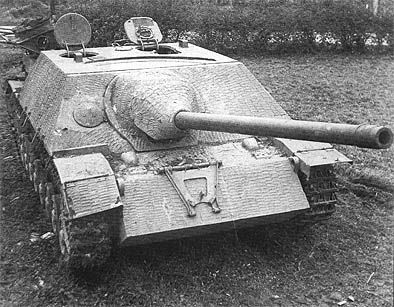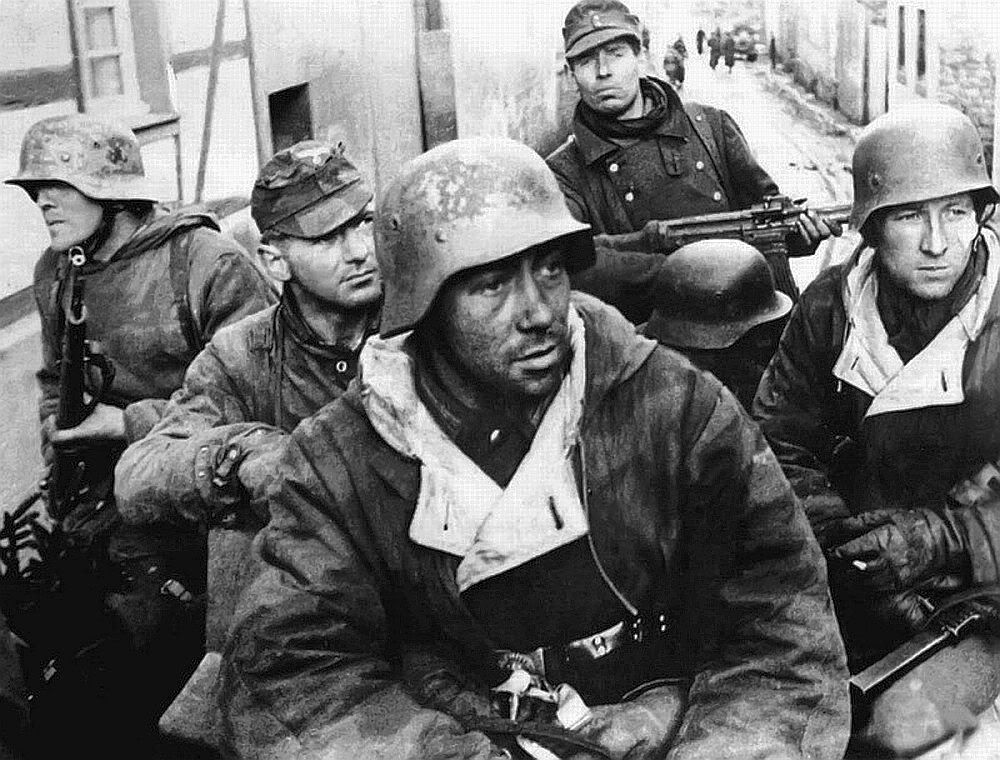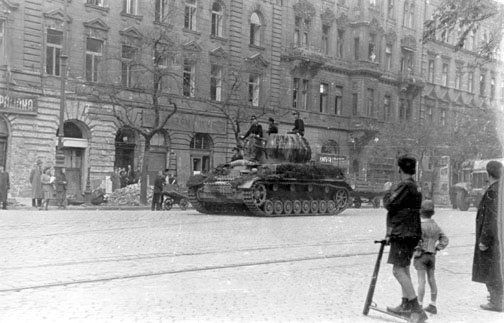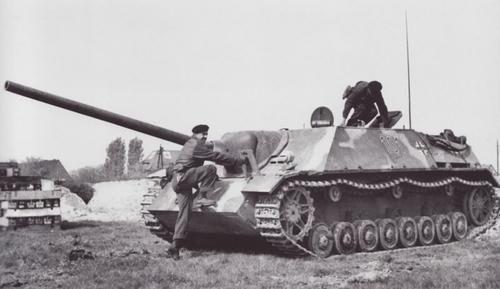4. / 2109. Panzer-Abteilung; Panzerbrigade 109 "Feldherrnhalle" [Grey Wolf]
Confident Veteran
Kompanie
# Gruppe Führer
2x Panzer IV/70(V) ............................................=300p
> 1. Zug
3x Panzer IV/70(V) ............................................=450p
> 2. Zug
3x Panzer IV/70(V) ............................................=450p
Abteilung
> Fliegerabwehrzug
2x Sd.Kfz. 7/1 ..................................................=100p
Brigade
> gepanzerte Panzergrenadierzug
220p +10p (Panzerfaust) .................................=230p
> Panzeraufklärungszug
3x Sd.Kfz.250 ..................................................=115p
Korps
> Nebelwerferzug
3x NW 41 ...........................................................=105p
========================================1750p
Tras el éxito de los Kampfgruppen ad hoc (como el famoso Kampfgruppe Bäke) en las batallas defensivas que se sucedieron durante la ofensiva de Bagration, Hitler decidió crear unidades permanentes, más pequeñas y flexibles que las Panzerdivisionen para combatir las puntas de lanza acorazadas aliadas, esperando exportar la exitosa experiencia del Ostfront al frente occidental. Así nacieron las Panzerbrigaden, inicialmente del tamaño de un regimiento, con un Panzer-Abteilung y un Panzergrenadier-Bataillon. En las Panzerbrigaden 105-110 la 4. Kompanie del batallón Panzer estaba constituida por los nuevos y prometedores Panzer IV/70(V), con 11 ejemplares, armados con el poderoso PaK 42 del Panther (cañón, por cierto, que fue diseñado para equipar al Tiger I).
Following the success of the ad-hoc Kampfgruppen (like the famous Kampfgruppe Bäke) in the defensive battles after Bagration offensive, Hitler decided to create permanent formations, smaller and more flexible than Panzerdivisionen to face Allied armoured spearheads, expecting to export the successful experience from the Eastern Front to the West. Thus Panzerbrigaden were born, initially the size of a Regiment, that is: a Panzer-Abteilung and a Panzergrenadier-Bataillon. In Panzerbrigaden 105-110 the 4. Panzer Kompanie housed the new and promising Panzer IV/70 (V), -11 units- armed with the powerful PaK 42 the same as Panther (designed to equip the Tiger I).
No obstante, el concepto de las brigadas Panzer se demostró equivocado. Sin artillería orgánica y con dotaciones muy reducidas de ingenieros, mantenimiento y, sobre todo, de reconocimiento, su actuación en el frente occidental, más abrupto y propicio para las emboscadas, fue decepcionante. Aún peor, para su formación se invirtieron recursos que hubiesen sido extremadamente valiosos para fortalecer las exhaustas divisiones Panzer.
However, the concept of Panzer Brigades was flawed from the start. With no organic artillery and only small cadres of engineers, mechanics and, above all, reconnaissance assets, their performance on the Western Front, more abrupt and suitable for ambushes, was disappointing at best. Even worse, they swallowed large amounts of resources that would had been extremely valuable to reinforce the battered Panzer divisions instead.
Las Panzerbrigaden tuvieron una breve vida operativa y acabaron siendo absorbidas por divisiones Panzer o Panzergrenadier. Este es el caso de la brigada que nos ocupa, la 109. "Feldherrnhalle", formada el 19 de Julio de 1944 en Grafenwöhr a partir de un reducido número de veteranos de las SA y enviada apresuradamente a Hungría para detener la penetración soviética hacia Budapest. Esta brigada se integraría en Octubre-Noviembre de ese año en la Panzergrenadier-Division "Feldherrnhalle", que luego cambiaría su nombre por Panzerdivision.
The Panzerbrigaden had a short operational life and were eventually absorbed by Panzergrenadier or Panzer Divisions. That was the case of the 109. "Feldherrnhalle", formed on July 19, 1944 in Grafenwöhr from a small cadre of SA veterans and hastily thrown to Hungary to halt the Soviet thrust to Budapest. This Brigade would merge in October-November with Panzergrenadier-Division "Feldherrnhalle", which changed its name for Panzerdivision.
Las presas predilectas son, naturalmente, las formaciones acorazadas soviéticas por pesadas que sean, ofreciendo también un buen desempeño frente a los tanques occidentales siempre que podamos evitar los flanqueos. Por el contrario, formaciones de infantería en posiciones preparadas serán su previsible enemigo natural y más todavía en terreno difícil. Por otro lado, si el enemigo no está atrincherado penetraremos profundamente con la infantería acorazada y el pelotón de reconocimiento bajo el apoyo de los Panzerjäger y una oportuna columna de humo.
Favorite prey are, of course, Soviet armoured formations, the heavier, the better, offering a good performance against Western tanks as well, provided we can prevent outflanking. By contrast, infantry formations in prepared positions will be our nemesis, even more on difficult terrain. On the other hand, if the enemy is not dug in we can spearhead with our armoured infantry and reconnaissance platoon under the long range support of our Panzerjägers and a timely smoke bombardment.
Following the success of the ad-hoc Kampfgruppen (like the famous Kampfgruppe Bäke) in the defensive battles after Bagration offensive, Hitler decided to create permanent formations, smaller and more flexible than Panzerdivisionen to face Allied armoured spearheads, expecting to export the successful experience from the Eastern Front to the West. Thus Panzerbrigaden were born, initially the size of a Regiment, that is: a Panzer-Abteilung and a Panzergrenadier-Bataillon. In Panzerbrigaden 105-110 the 4. Panzer Kompanie housed the new and promising Panzer IV/70 (V), -11 units- armed with the powerful PaK 42 the same as Panther (designed to equip the Tiger I).
No obstante, el concepto de las brigadas Panzer se demostró equivocado. Sin artillería orgánica y con dotaciones muy reducidas de ingenieros, mantenimiento y, sobre todo, de reconocimiento, su actuación en el frente occidental, más abrupto y propicio para las emboscadas, fue decepcionante. Aún peor, para su formación se invirtieron recursos que hubiesen sido extremadamente valiosos para fortalecer las exhaustas divisiones Panzer.
However, the concept of Panzer Brigades was flawed from the start. With no organic artillery and only small cadres of engineers, mechanics and, above all, reconnaissance assets, their performance on the Western Front, more abrupt and suitable for ambushes, was disappointing at best. Even worse, they swallowed large amounts of resources that would had been extremely valuable to reinforce the battered Panzer divisions instead.
Las Panzerbrigaden tuvieron una breve vida operativa y acabaron siendo absorbidas por divisiones Panzer o Panzergrenadier. Este es el caso de la brigada que nos ocupa, la 109. "Feldherrnhalle", formada el 19 de Julio de 1944 en Grafenwöhr a partir de un reducido número de veteranos de las SA y enviada apresuradamente a Hungría para detener la penetración soviética hacia Budapest. Esta brigada se integraría en Octubre-Noviembre de ese año en la Panzergrenadier-Division "Feldherrnhalle", que luego cambiaría su nombre por Panzerdivision.
The Panzerbrigaden had a short operational life and were eventually absorbed by Panzergrenadier or Panzer Divisions. That was the case of the 109. "Feldherrnhalle", formed on July 19, 1944 in Grafenwöhr from a small cadre of SA veterans and hastily thrown to Hungary to halt the Soviet thrust to Budapest. This Brigade would merge in October-November with Panzergrenadier-Division "Feldherrnhalle", which changed its name for Panzerdivision.
Las presas predilectas son, naturalmente, las formaciones acorazadas soviéticas por pesadas que sean, ofreciendo también un buen desempeño frente a los tanques occidentales siempre que podamos evitar los flanqueos. Por el contrario, formaciones de infantería en posiciones preparadas serán su previsible enemigo natural y más todavía en terreno difícil. Por otro lado, si el enemigo no está atrincherado penetraremos profundamente con la infantería acorazada y el pelotón de reconocimiento bajo el apoyo de los Panzerjäger y una oportuna columna de humo.
Favorite prey are, of course, Soviet armoured formations, the heavier, the better, offering a good performance against Western tanks as well, provided we can prevent outflanking. By contrast, infantry formations in prepared positions will be our nemesis, even more on difficult terrain. On the other hand, if the enemy is not dug in we can spearhead with our armoured infantry and reconnaissance platoon under the long range support of our Panzerjägers and a timely smoke bombardment.






No hay comentarios:
Publicar un comentario